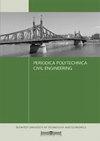用致密充填和响应面法优化含碎石和废石水泥混凝土的工程性能
IF 1.4
4区 工程技术
Q3 ENGINEERING, CIVIL
引用次数: 0
摘要
本研究介绍了一种优化混凝土中骨料颗粒分布的新方法。利用当地可用的材料,如砾石和废石,作为一种可持续的替代传统材料,如山石和河砂,这是消耗。确定最大堆积密度需要一个有效的过程,即逐渐向混合物中加入不同粒径的砾石和废石。容器的振动压实有助于确定这些骨料的最佳组合百分比。此外,研究还解决了混凝土孔隙率的问题。考虑和易性、抗压强度、抗折强度和弹性模量等重要因素,采用响应面法优化混凝土配合比。这种响应面方法允许数学模型的发展,以帮助确定最佳混合比。通过挖掘碎石和废石的潜力,结合响应面法(RSM),基于合理的骨料颗粒分布,制备抗压强度要求在30 ~ 35 MPa的含碎石和废石水泥混凝土(WR),最大限度地减少不可生物降解废弃物的处置,从而减少环境污染。此外,利用当地可用的材料有助于有效地利用该地区的资源进行混凝土生产,促进可持续性并减少对稀缺资源的依赖。所提出的方法提出了一个有希望的方法来优化骨料分布在混凝土,同时考虑到越南西北地区具体的环境和资源限制。本文章由计算机程序翻译,如有差异,请以英文原文为准。
Optimization of the Engineering Properties of Cement Concrete Containing Gravel and Waste Rock Using Dense Packing and Response Surface Methodology
This study introduces a novel methodology for optimizing the distribution of aggregate particles in concrete. Utilizing locally available materials like gravel and waste rock is explored as a sustainable alternative to conventional materials like mountain rock and river sand, which are depleting. Determining the maximum bulk density involves an efficient process of gradually adding different particle sizes of gravel and waste rock to the mixture. The vibrational compaction of the container aids in identifying the optimally combined percentages of these aggregates. Besides, the study also addresses the issue of porosity in concrete. The response surface methodology is employed to optimize the mixture proportions for concrete, considering important factors such as workability, compressive strength, flexural strength, and elastic modulus. This response surface methodology allows for the development of mathematical models that aid in determining the optimal mix ratios. By exploiting the potential of gravel and waste rock, this study aims to procedure cement concrete containing gravels and waste rock (WR) with required compressive strength from 30 MPa to 35 MPa based on reasonable aggregate particle distribution in combination with response surface methodology (RSM) and minimize the disposal of non-biodegradable waste, thereby reducing the environmental pollution. Additionally, utilizing locally available materials helps to effectively use the region's resources for concrete production, promoting sustainability and reducing dependency on scarce resources. The proposed method presents a promising approach to optimizing aggregate distribution in concrete while considering the environmental and resource constraints specific to the Northwest region of Vietnam.
求助全文
通过发布文献求助,成功后即可免费获取论文全文。
去求助
来源期刊

Periodica Polytechnica-Civil Engineering
工程技术-工程:土木
CiteScore
3.40
自引率
16.70%
发文量
89
审稿时长
12 months
期刊介绍:
Periodica Polytechnica Civil Engineering is a peer reviewed scientific journal published by the Faculty of Civil Engineering of the Budapest University of Technology and Economics. It was founded in 1957. Publication frequency: quarterly.
Periodica Polytechnica Civil Engineering publishes both research and application oriented papers, in the area of civil engineering.
The main scope of the journal is to publish original research articles in the wide field of civil engineering, including geodesy and surveying, construction materials and engineering geology, photogrammetry and geoinformatics, geotechnics, structural engineering, architectural engineering, structural mechanics, highway and railway engineering, hydraulic and water resources engineering, sanitary and environmental engineering, engineering optimisation and history of civil engineering. The journal is abstracted by several international databases, see the main page.
 求助内容:
求助内容: 应助结果提醒方式:
应助结果提醒方式:


